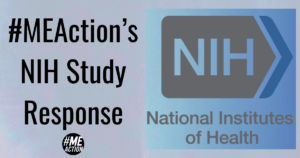August was a mixed month in the world of ME research, with some truly innovative studies coming out and a few that needed another couple of rounds with the thesis advisor. Some great books and book chapters debuted — and we faced Afflicted, battling not only the usual stigma, but the directors’ framing of chronically ill patients as blind believers in pseudoscience. All the more reason to roll up our sleeves and get reading, so without further ado:

Hyperintense sensorimotor T1 spin echo MRI is associated with brainstem abnormality in chronic fatigue syndrome by Barnden et al. (including Marshall-Gradisnik) is a paper we somehow missed last month! In Fukuda-diagnosed patients, there was a decreased signal-level in the brainstem, and increased signal-levels in the sensorimotor cortex. Moreover, the brainstem values inversely proportional to the sensorimotor values for both CFS and healthy controls. This relationship, previously unreported in either healthy controls or CFS, suggests brainstem conduction deficits in CFS may stimulate the upregulation of myelin in the sensorimotor cortex to maintain brainstem – sensorimotor connectivity. This isn’t the first paper Barnden has produced that has found brainstem abnormalities in ME patients; he also published Autonomic correlations with MRI are abnormal in the brainstem vasomotor centre in Chronic Fatigue Syndrome in 2016. Dr Baraniuk presented on brainstem abnormalities in ME in the 2016 Invest in ME conference.

The expression signature of very long non-coding RNA in myalgic encephalomyelitis/chronic fatigue syndrome discusses the possibility of the involvement of long, non-coding RNAs (lncRNAs) in ME. There is already evidence of increased lncRNAs in both cancer and neurological diseases. While their role in disease processes are not well-understood, they have important functions in transcription, translation, and in epigenetics. They are considered potential markers for neurological disease. The lncRNAs NTT, MIAT and EmX2OS were found to be significantly elevated in ME — and moreover, two correlated with disease severity.
 A new approach to find biomarkers in chronic fatigue syndrome/myalgic encephalomyelitis (CFS/ME) by single-cell Raman micro-spectroscopy utilizes a fascinating new technology: Raman micro-spectroscopy, or SCRS. A single cell’s Raman spectrum contains Raman bands, which provide information about that single cell, including nucleic acids, protein, carbohydrates and lipids, reflecting the cell’s genotype, phenotype and physiological state. In short, a Raman spectrum serves as a molecular ‘fingerprint’ of a single cell. In this study, the researchers examined SCRS from ρ0 cells that lack mitochondrial DNA, and PBMCs (blood cells) from CFS patients and healthy controls. In both cell types, the phenylalanine bands were significantly stronger in CFS patients — a finding replicated in diseases of mitochondrial dysfunction. Using these bands plus machine learning, the researchers were able to separate patients from healthy controls 98% of the time.
A new approach to find biomarkers in chronic fatigue syndrome/myalgic encephalomyelitis (CFS/ME) by single-cell Raman micro-spectroscopy utilizes a fascinating new technology: Raman micro-spectroscopy, or SCRS. A single cell’s Raman spectrum contains Raman bands, which provide information about that single cell, including nucleic acids, protein, carbohydrates and lipids, reflecting the cell’s genotype, phenotype and physiological state. In short, a Raman spectrum serves as a molecular ‘fingerprint’ of a single cell. In this study, the researchers examined SCRS from ρ0 cells that lack mitochondrial DNA, and PBMCs (blood cells) from CFS patients and healthy controls. In both cell types, the phenylalanine bands were significantly stronger in CFS patients — a finding replicated in diseases of mitochondrial dysfunction. Using these bands plus machine learning, the researchers were able to separate patients from healthy controls 98% of the time.

In Visual aspects of reading performance in myalgic encephalomyelitis (ME), Wilson and colleagues looked to objectively measure visual aspects of reading performance of ME patients (specifically acuity and speed) and compare their scores with that of healthy control subjects. Their results suggest that vision-related reading difficulty is a quantitative symptom of ME.

Loss of Transient Receptor Potential Melastatin 3 ion channel function in natural killer cells from Chronic Fatigue Syndrome/Myalgic Encephalomyelitis patients aimed to correlate dysfunction of ion channel functioning in NK cells in those with ME to healthy controls. Cabanas and colleagues (Marshall-Gradisnik’s team) found impaired activity of NK cell calcium ion regulation in those with ME. Transient Receptor Potential Melastatin 3 (TRPM3) channels are thought to play a role in glucose processing, homeostasis, and pain and temperature sensation. This was a very small study and the results must be replicated.

Metabolic features and regulation of the healing cycle—A new model for chronic disease pathogenesis and treatment by Robert Naviaux. In a mammoth paper that’s more like a graduate thesis than an article, Naviaux outlines his senescence theory of chronic disease in greater detail.
 The association of adverse events with bivalent human papilloma virus vaccination: A nationwide register-based cohort study in Finland by Skufka et al. found that HPV vaccination was not associated with ME onset.
The association of adverse events with bivalent human papilloma virus vaccination: A nationwide register-based cohort study in Finland by Skufka et al. found that HPV vaccination was not associated with ME onset.
Elwood, J. M., & Ameratunga, R. in Autoimmune diseases after hepatitis B immunization in adults: Literature review and meta-analysis, with reference to “autoimmune/autoinflammatory syndrome induced by adjuvants also found that there was no link between hepatitis B vaccine and several different autoimmune disorders, including ME.
Wondering why there are so many studies on ME and vaccination all of a sudden? Other research has found vaccine-induced autoimmune reactions occur.
 A Concurrent Cognitive Task Does Not Perturb Quiet Standing in Fibromyalgia and Chronic Fatigue Syndrome by Rasouli et al. is a small study that demonstrates that patients with FM and ME have greater difficulty engaging in cognitive tasks than healthy controls. Rasouli et al. hypothesized that the need to maintain balance would adversely affect cognitive performance, but this was not supported by their data. Each test took a very brief period of time (60s), which may prevent effects stemming from delayed postural symptoms or processes.
A Concurrent Cognitive Task Does Not Perturb Quiet Standing in Fibromyalgia and Chronic Fatigue Syndrome by Rasouli et al. is a small study that demonstrates that patients with FM and ME have greater difficulty engaging in cognitive tasks than healthy controls. Rasouli et al. hypothesized that the need to maintain balance would adversely affect cognitive performance, but this was not supported by their data. Each test took a very brief period of time (60s), which may prevent effects stemming from delayed postural symptoms or processes.
Cardiopulmonary Exercise Test Methodology for Assessing Exertion Intolerance in Myalgic Encephalomyelitis/Chronic Fatigue Syndrome by Stevens et al. (of the Workwell group) is a review of 2-day CPET in ME and guides practitioners into performing 2-day CPET for ME patients and in other fatiguing disorders. Full text isn’t quite out yet on this one.
Vink and Vink-Niese’s paper: Multidisciplinary rehabilitation treatment is not effective for myalgic encephalomyelitis/ chronic fatigue syndrome: A review of the FatiGo trial is a critical review of FatiGo, an exercise-vs-CBT analysis in ME. A highlight: “…after CBT, which according to the authors has been proven to be effective for CFS/ME, patients were still ill enough to reenter the FatiGo trial.
A Canadian group of researchers published Cytotoxic Profiling of Endogenous Metabolites Relevant to Chronic Fatigue Immune Dysfunction Syndrome (CFIDS) on p53 Variant Human Colon Carcinoma Cell Lines to contextualize some of the preliminary data linking cancer and ME. Metabolic products can have an impact on the effectiveness of cancer outcomes. The researchers investigated the effect of phenyl acetate, ursodeoxycholate, and tauroursodeoxycholate (TUDCA) (all related to bile acids) on colon cancer cells and found that TUDCA had the strongest anti-cancer properties. Unfortunately, the authors appeared to throw in a CFIDS reference in a slapdash manner — it’s mentioned twice, once in the title and once in the text — under the presumption that cytotoxicity for cancer cell lines explains arrested growth or metabolism in people with ME. This is especially disappointing given that there was a surge of interest in TUDCA on Phoenix Rising about a year ago — and given that the funding for the study was from ME organizations.
Myalgic Encephalomyelitis/Chronic Fatigue Syndrome-Metabolic Disease or Disturbed Homeostasis? has quite a few errors. Vermeulen & Vermeulen did, in fact, compare their patients to sedentary controls, for example, and there is abundant evidence that ME onset is often post-viral. The following are stated as certainties where they are still hypotheses: ME is due to mitochondrial dysfunction; and ME patients are hypometabolic. This needed another review.
Brian Hughes, newcomer to the ME scene, recently published Psychology in Crisis, which featured a creditable analysis of the PACE Trial. Moreover, Hughes’s book is instructive, guiding the reader in key concepts early on and referencing them throughout the whole of the text. If it’s not being picked up by universities for study design, it should be. Can you add him to MEpedia?
Tom Kindlon announced this month that the 5th Ed. of Health Psychology: Health, Research, and Practice features a case history of ME — his own. The case study describes Kindlon’s symptoms and health history in his own words.
Tired All the Time by Marie Thomas – a treatise on CFS/ME from the BPS perspective. Notably doesn’t cite any modern research in GET and CBT section, and pharmacological section focuses on anxiety and depression.
And that’s our research roundup for August 2018. Keep reading and keep researching, everyone!





